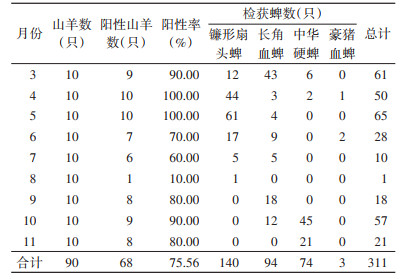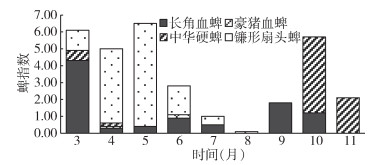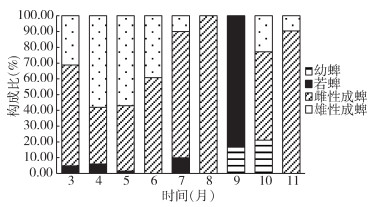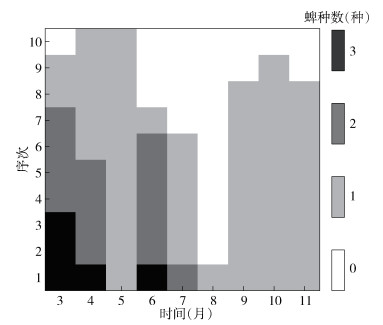扩展功能
文章信息
- 朱心红, 吴因平, 王金娜, 董选军, 陈莫娇, 楼挺
- ZHU Xin-hong, WU Yin-ping, WANG Jin-na, DONG Xuan-jun, CHEN Mo-jiao, LOU Ting
- 浙江省义乌市2020年山羊寄生蜱监测结果分析
- An analysis of the monitoring results of ticks in goats in Yiwu, Zhejiang province, China, 2020
- 中国媒介生物学及控制杂志, 2022, 33(2): 221-224
- Chin J Vector Biol & Control, 2022, 33(2): 221-224
- 10.11853/j.issn.1003.8280.2022.02.010
-
文章历史
- 收稿日期: 2022-01-12
2 浙江省疾病预防控制中心, 浙江 杭州 310051
2 Zhejiang Center for Disease Control and Prevention, Hangzhou, Zhejiang 310051, China
蜱是一类体型较小的专性寄生节肢动物,其生活史经过卵、幼、若及成蜱4个发育阶段,除卵期外,各发育阶段均需吸血。蜱常常需要2~3种宿主才能完成一个生命周期,更换宿主过程中增加了感染病原体机会[1-2],是仅次于蚊虫的重要传播媒介[3]。我国蜱所携带的病原体达103种,包括病毒、细菌、原生动物和蠕虫[4]。义乌市地处浙江省中部,是温暖和煦、地貌多变、野生动物种类繁多的丘陵县,适合多种蜱类生存。而山羊寄生蜱具有种类多及感染率高特点[5],调查山羊蜱寄生情况,有助于了解当地人居环境周边常见蜱种类和活动情况,有重要的公共卫生学意义。为初步掌握义乌市山羊染蜱种类、密度及季节消长,本研究在2020年对一群放养山羊开展了连续的寄生蜱监测。
1 材料与方法 1.1 调查时间与地点2020年3-11月,选取义乌市赤岸镇有一定规模的一群放养山羊为监测对象,在每月下旬开展山羊的寄生蜱监测工作。该群山羊除雨天外均采取自由活动方式放养,同时未采取任何蜱媒病的防控措施。
1.2 监测工具眼科镊子、离心管、防水记号笔、带盖玻璃小瓶、体视显微镜。
1.3 监测方法寄生蜱采用体表检蜱法。每月对预先围圈在一起的放养山羊随机抓获10只开展监测,检后即放,防止与未检蜱山羊相混,保证监测有序进行。在对监测山羊适当固定的情况下,由经过培训的承担监测任务的有害生物防治公司工作人员重点检查耳朵、眼睛周围、口鼻周围、脖子、腋窝、胸脯、乳房、大腿根、阴囊、肛周、会阴、尾根等部位,检蜱时至少有1名疾病预防控制中心(疾控中心)病媒科人员在场,帮助检蜱同时对监测人员进行指导及监督,保证监测过程合乎规范。

|
监测时对检获蜱编号,带回实验室,区分幼蜱、若蜱、成蜱,并参照《中国重要医学昆虫分类与鉴别》[6]依照其形态特征逐一对照关键部位进行鉴定,确定蜱种类。
1.5 统计分析采用Excel 2010和Origin 2021软件建立数据库并进行绘图分析。
2 结果 2.1 一般情况2020年3-11月共监测山羊90只,其中监测到被蜱叮咬的阳性山羊68只,阳性率为75.56%,检获蜱类311只,蜱指数为3.46。
2.2 各月山羊寄生蜱阳性率及蜱种群构成山羊寄生蜱阳性率8月较低,仅为10.00%,其他各月阳性率均在60.00%及以上,在4、5月阳性率甚至达到100%。检获蜱4种:镰形扇头蜱(Rhipicephalus haemaphysaloides)140只,占全部蜱的45.02%;长角血蜱(Haemaphysalis longicornis)94只,占30.23%;中华硬蜱(Ixodes sinensis)74只,占23.79%,豪猪血蜱(H. hystricis)3只,占0.96%。见表 1。

|
时间分布以3-5月和10月蜱指数较高,8月蜱指数较低。各月蜱种类有所不同:镰形扇头蜱在3-8月均有检获,4-5月蜱指数迅速上升,5月达到高峰,6月快速下降,直到9月消失;长角血蜱除8和11月未发现外其他月份均有检获,3月检获数量最多;中华硬蜱3-4、10-11月均有检获,主要集中在10和11月;豪猪血蜱数量较少,仅在4和6月有检获。见图 1。

|
| 图 1 2020年浙江省义乌市3-11月山羊体表寄生蜱季节消长情况 Figure 1 Seasonal variation of ticks in goats from March to November 2020 in Yiwu, Zhejiang province |
| |
在山羊体表检获主要为成蜱,除4-5月雄性成蜱占比较高外,其他月份均以雌性成蜱为多;若蜱3-5、7和9月有少量检获;幼蜱仅9-10月有检获,均为长角血蜱。见图 2。

|
| 图 2 浙江省义乌市2020年不同月份山羊体表寄生蜱态及性别构成 Figure 2 Developmental stages and sex composition of ticks in goats in different months in 2020 in Yiwu, Zhejiang province |
| |
从检获蜱情况发现,同时感染3种蜱的山羊有5只,占全部山羊的5.56%,均为长角血蜱、镰形扇头蜱及中华硬蜱同时感染;同时感染2种蜱的山羊14只,占全部山羊的15.56%,其中同时感染长角血蜱与镰形扇头蜱的有11只,同时感染镰形扇头蜱与中华硬蜱的有2只,同时感染豪猪血蜱与镰形扇头蜱的有1只;多蜱种感染单只山羊以3、4、6月为多,占全部多蜱种感染单只山羊的94.74%,而5、8-11月未发现多蜱种感染单只山羊现象。见图 3。

|
| 图 3 浙江省义乌市2020年3-11月单只山羊感染蜱种数量热图 Figure 3 Heat map of the species numbers of ticks infesting a single goat from March to November 2020 in Yiwu, Zhejiang province |
| |
监测发现,义乌市山羊在3-11月均有蜱寄生,除8月外阳性率均较高,表明放养的环境中长年有蜱孳生。山羊寄生蜱种有镰形扇头蜱、长角血蜱、中华硬蜱和豪猪血蜱,其中,镰形扇头蜱为优势蜱种,推测可能与监测地有松树林覆盖,适宜镰形扇头蜱生存有关[7]。2019年初是暖冬气候,十分适宜镰形扇头蜱在年初生长繁殖[7-8],可能是3-5月蜱指数升高的原因。长角血蜱活动于3-10月,与河北省野外长角血蜱研究基本一致[9];中华硬蜱仅在3-4和10-11月有捕获,与郑寿贵等[10]研究结果一致。
监测显示寄生于山羊体表上的蜱以成蜱为多,幼蜱和若蜱较少,这与幼蜱、若蜱常寄生于小型宿主而成蜱寄生于较大型宿主的习性一致。9-10月长角血蜱幼、若蜱构成比相对增加,此阶段比气温较低的河北省稍为延迟,为蜱卵孵化旺盛时期[9]。
监测表明,从春天至初夏,除寄生蜱指数较高外,还在山羊体表形成多种蜱同时寄生现象。而有生活史差异的不同蜱种相互交集,易引起病原体扩散[11],形成复杂生态,是蜱病原生物多样性的驱动因素之一[12]。
义乌市近年来时有蜱传发热伴血小板减少综合征(SFTS)发生,分布于多个镇街,而山羊体内的SFTS病原体新布尼亚病毒的抗体阳性率比牛、犬、鸡和猪等家畜(禽)均高[13],是最具扩散功能的蜱宿主[14]。长角血蜱是该疾病的最主要传播媒介[15],中华硬蜱也是该病传播媒介之一[16],本次监测结果显示长角血蜱出现时间跨度也与SFTS病例发生基本重合[17]。2017年义乌市首次发现斑点热病例[18],虽然其他蜱媒疾病未见上报,但仍不可掉以轻心,因为大多数蜱传疾病临床症状不典型,临床医生也对其缺乏了解,蜱传疾病未受到应有的重视,诊断时往往不将蜱传疾病作为诊断备选项,因此容易引起被误诊和漏诊[19],柴程良等[20]曾对与义乌市西南接壤的金东区人群进行8种常见蜱传病原体血清流行病学监测,这8种病原体的IgG抗体均被监测到,表明这几种蜱传病原体可能都曾经感染过金东区居民。
总之义乌市山羊蜱寄生阳性率较高,寄生有多个蜱种,幼、若、成蜱等多个发育阶段均可发现,有可能传播蜱传疾病,应引起重视,有必要扩大范围开展蜱及蜱传病原体的进一步监测和研究。
志谢 本研究承蒙浙江省疾病预防控制中心侯娟、李天奇医师进行蜱鉴定指导,特此志谢利益冲突 无
| [1] |
潘晓倩, 姚广琴, 张忠, 等. 血餐对蜱类共生细菌多样性的影响[J]. 中国病原生物学杂志, 2017, 12(1): 99-101. Pan XQ, Yao GQ, Zhang Z, et al. Effects of bloodmeals on the diversity of symbiotic bacteria in ticks[J]. J Pathog Biol, 2017, 12(1): 99-101. DOI:10.13350/j.cjpb.170123 |
| [2] |
Zhang YK, Zhang XY, Liu JZ. Ticks (Acari: Ixodoidea) in China: Geographical distribution, host diversity, and specificity[J]. Arch Insect Biochem Physiol, 2019, 102(3): e21544. DOI:10.1002/arch.21544 |
| [3] |
陈锐, 寇增强, 温红玲. 我国常见蜱传疾病的流行病学研究进展[J]. 中华实验和临床病毒学杂志, 2020, 34(1): 102-106. Chen R, Kou ZQ, Wen HL. Epidemiological studies of common tick-borne diseases in China[J]. Chin J Exp Clin Virol, 2020, 34(1): 102-106. DOI:10.3760/cma.j.issn.1003-9279.2020.01.021 |
| [4] |
Zhao GP, Wang YX, Fan ZW, et al. Mapping ticks and tick-borne pathogens in China[J]. Nat Commun, 2021, 12: 1075. DOI:10.1038/s41467-021-21375-1 |
| [5] |
Soundararajan C, Nagarajan K, Muthukrishnan S, et al. Tick infestation on sheep, goat, horse and wild hare in Tamil Nadu[J]. J Parasit Dis, 2018, 42(1): 127-129. DOI:10.1007/s12639-018-0977-z |
| [6] |
陆宝麟, 吴厚永. 中国重要医学昆虫分类与鉴别[M]. 郑州: 河南科学技术出版, 2003: 21-52. Lu BL, Wu HY. Classification and identification of important medical insects of China[M]. Zhengzhou: Henan Science and Technology Press, 2003: 21-52. |
| [7] |
赵国平. 中国蜱类空间分布及其危害预测[D]. 北京: 军事科学院, 2018. Zhao GP. Spatial distribution of ticks and their hazard prediction in China[D]. Beijing: Academy of Military Sciences, 2018. (in Chinese) |
| [8] |
李莹, 曾红玲, 王国复, 等. 2019年中国气候主要特征及主要天气气候事件[J]. 气象, 2020, 46(4): 547-555. Li Y, Zeng HL, Wang GF, et al. Climatic characteristics and major meteorological events over China in 2019[J]. Meteorol Mon, 2020, 46(4): 547-555. DOI:10.7519/j.issn.1000-0526.2020.04.009 |
| [9] |
田雪斌. 河北省蜱类分布以及优势蜱种群动态和生活史研究[D]. 承德: 承德医学院, 2019. Tian XB. Study on species and distribution of ticks and population dynamics and life cycle of dominant ticks in Hebei province[D]. Chengde: Chengde Medical University, 2019. (in Chinese) |
| [10] |
郑寿贵, 叶晓东, 郑海鸥, 等. 金华地区家畜和野生动物体表寄生蜱类调查[J]. 中国媒介生物学及控制杂志, 2007, 18(1): 32-34. Zheng SG, Ye XD, Zheng HO, et al. About the ticks parasitizing on domestic and wild animals in Jinhua, Zhejiang province[J]. Chin J Vector Biol Control, 2007, 18(1): 32-34. DOI:10.3969/j.issn.1003-4692.2007.01.011 |
| [11] |
Scott JD, Clark KL, Durden LA. Presence of Babesia odocoilei and Borrelia burgdorferi Sensu Stricto in a tick and dual parasitism of Amblyomma inornatum and Ixodes scapularis on a bird in Canada[J]. Healthcare, 2019, 7(1): 46. DOI:10.3390/healthcare7010046 |
| [12] |
Rynkiewicz EC, Hemmerich C, Rusch DB, et al. Concordance of bacterial communities of two tick species and blood of their shared rodent host[J]. Mol Ecol, 2015, 24(10): 2566-2579. DOI:10.1111/mec.13187 |
| [13] |
Wang D, Wang YM, Yang GL, et al. Ticks and tick-borne novel bunyavirus collected from the natural environment and domestic animals in Ji'nan city, East China[J]. Exp Appl Acarol, 2016, 68(2): 213-221. DOI:10.1007/s10493-015-9992-2 |
| [14] |
Li ZF, Bao CJ, Hu JL, et al. Ecology of the tick-borne phlebovirus causing severe fever with thrombocytopenia syndrome in an endemic area of China[J]. PLoS Negl Trop Dis, 2016, 10(4): e0004574. DOI:10.1371/journal.pntd.0004574 |
| [15] |
Luo LM, Zhao L, Wen HL, et al. Haemaphysalis longicornis ticks as reservoir and vector of severe fever with thrombocytopenia syndrome virus in China[J]. Emerg Infect Dis, 2015, 21(10): 1770-1776. DOI:10.3201/eid2110.150126 |
| [16] |
胡媛媛. 不同蜱种对发热伴血小板减少综合征病毒传播能力的研究[D]. 合肥: 安徽医科大学, 2020. Hu YY. Study on the transmission of severe fever with thrombocytopenia syndrome virus in different tick species[D]. Hefei: Anhui Medical University, 2020. (in Chinese) |
| [17] |
叶小红, 张慧利, 郑建军. 2012-2014年临海市发热伴血小板减少综合征流行特点及病原学监测结果分析[J]. 中国病原生物学杂志, 2015, 10(3): 265-267. Ye XH, Zhang HL, Zheng JJ. Epidemiological and etiological characteristics of severe fever with thrombocytopenia syndrome in Linhai from 2012-2014[J]. J Pathog Biol, 2015, 10(3): 265-267. DOI:10.13350/j.cjpb.150318 |
| [18] |
黄怡松, 楼莲青, 盛丽娜, 等. 浙江省义乌市首例斑点热临床分析[J]. 中华临床感染病杂志, 2019, 12(1): 56-59. Huang YS, Lou LQ, Sheng LN, et al. Clinical analysis of the first spotted fever in Yiwu city, Zhejiang province[J]. Chin J Clin Infect Dis, 2019, 12(1): 56-59. DOI:10.3760/cma.j.issn.1674-2397.2019.01.009 |
| [19] |
刘玮. 中国新发蜱媒病原体概况[J]. 传染病信息, 2017, 30(1): 11-14. Liu W. Emerging tick borne agents in China[J]. Infect Dis Inf, 2017, 30(1): 11-14. DOI:10.3969/j.issn.1007-8134.2017.01.005 |
| [20] |
柴程良, 陆群英, 孙继民, 等. 浙江省人和家畜蜱媒传染病血清流行病学调查[J]. 中华流行病学杂志, 2010, 31(10): 1144-1147. Chai CL, Lu QY, Sun JM, et al. Sero-epidemiologic investigation on tick-borne diseases of humans and domestic animals in Zhejiang province[J]. Chin J Epidemiol, 2010, 31(10): 1144-1147. DOI:10.3760/cma.j.issn.0254-6450.2010.10.016 |
 2022, Vol. 33
2022, Vol. 33
